Last Updated on January 12, 2024 by Kittredge Cherry
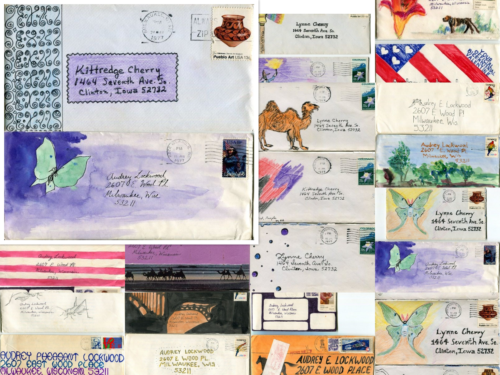
Q Spirit founder Kittredge Lynne Cherry and her spouse Audrey Lockwood are sharing their love-letter postal art from the 1970s to celebrate their 35th anniversary.
The 40 artistic envelopes are posted online for the first time today. The lesbian couple sent them in 1975-77, when they were 18 to 20 years old. They saved the letters for more than 45 years.
“We are sharing the envelopes from our love letters now to inspire others and preserve our legacy,” Kitt said.
They hope that people will each give $35 — a dollar for each year of their anniversary. Gifts of any amount are welcome. You can contribute now by visiting their 35th Anniversary GoFundMe page.
Both Kitt and Audrey were University of Iowa students when they created these envelopes. They fell in love on campus, but during winter and summer breaks they went back to their parents’ homes and had to communicate by what is now called “snail mail.” Kitt returned to Clinton, Iowa, and Audrey went back to Milwaukee, Wisconsin. Out of the obstacles, a beautiful record of their lesbian love was born.
While many of their peers were enthralled by football games, disco music and beer parties, Kitt and Audrey spent hours drawing armadillos and Luna moths for each other, inventing their own secret language of love.
“This was before Harvey Milk was killed. We were two lesbians at the University of Iowa, breaking barriers, creative, determined, unstoppable, and literary in the tradition of Gertrude Stein and Alice B. Toklas. While the other girls on our dorm hall were partying and smoking pot, we had a larger vision. We knew we were going places,” Audrey recalled.
Most of Audrey’s letters are addressed to “Lynne Cherry” instead of “Kittredge Cherry,” because Kitt was primarily using her middle name (Lynne) at that time.
They made a public commitment to each other in a Holy Union church wedding on April 11, 1987, at Metropolitan Community Churches. After decades of activism for LGBTQ rights and marriage equality, Kitt and Audrey were finally able to marry legally on May 4, 2016, at the Beverly Hills Courthouse. For the full story of their relationship, see Q Spirit’s related post: Celebrate 35th anniversary of “beautiful couple” Kittredge and Audrey’s same-sex wedding.
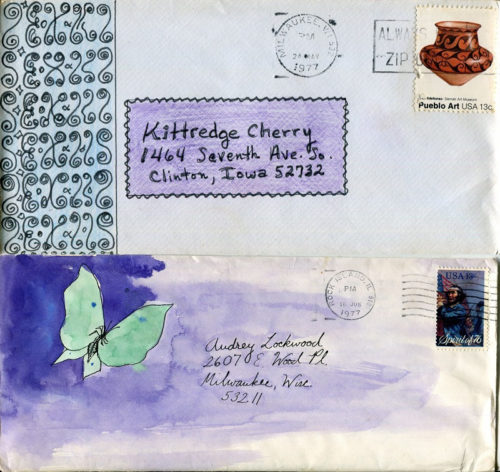
Kitt and Audrey drew Luna Moths and other creatures on the envelopes of their love letters from 1975-77.
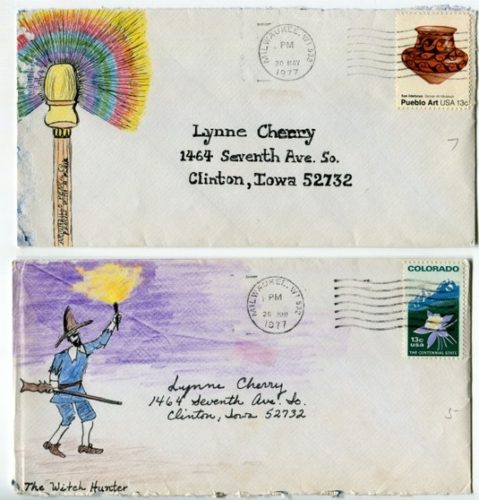
Rainbow light shines from the eraser of a pencil inscribed “Armadillo Pencil Co. Pencils with a flair” on one of Audrey’s envelopes. But she didn’t avoid the dark side. “I was learning about the witch trials in Salem in women’s studies classes, so I had to depict the evils of the witch hunters and the horrors of that era,” Audrey explains. These are two of her most creative envelopes.
Postal art provides a record of their love
The envelopes show how the two young lovers created their own world full of coded symbols, historical references and favorite animals. Kitt and Audrey stayed completely in the closet about their lesbian relationship during the homophobic era of the 1970s and early 1980s. They did not come out to anyone else until almost a decade later in 1985. “In the early years, nobody knew but us,” Audrey said.
Both were amazed when they dug the letters out of dusty boxes in the garage. “It’s like finding a long-lost treasure,” Kitt said. “We remember making these envelopes, but we forgot how elaborate and beautiful they were. Looking back at them helps me see that we were meant to be together from the beginning.”
Their unique visual vocabulary provides a pictorial narrative of what they were studying: Kitt was majoring in art/art history and journalism, while Audrey was a political science major with dreams of running for U.S. president. Raised in a mostly secular family, Kitt was still about six years away from her religious awakening and baptism in 1983, so there is little religious imagery.
Armadillos were their most important symbol. Both of them had liked armadillos since grade school — and Audrey even had one for a childhood pet! The creatures took on new meaning when the young lesbian couple got together. “We were armored creatures with hard shells to battle homophobia,” Audrey explained. The color orange makes a frequent appearance because it was the favorite color of both Kitt and Audrey before they met.
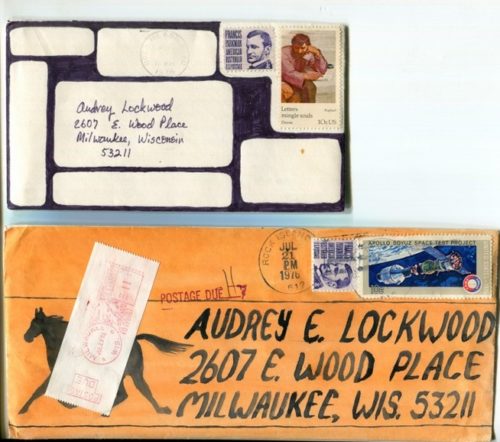
A postage-due stamp covers Kitt’s painting of a horse. Even the postage stamps were carefully chosen. Many come from a series of stamps with a quote from John Donne: “Letters mingle souls.” It is certainly true in this case. The Apollo-Soyuz stamp commemorates US-Russian cooperation in space and provides historical context here.
After unearthing the envelopes, even Kitt and Audrey had trouble figuring out why they used particular images and phrases 45 years . But they tried to decipher their envelopes for this article.
“They are time capsules that are unbelievable because we can decode our own artwork,” Audrey said. “Usually historians try to decode what artists meant, but we know because we are our own Da Vinci’s.”
Kitt added: “The challenge is to think back and remember what it all meant.”
Throughout history letters have been a particularly powerful form of communication for women. Kitt and Audrey’s correspondence fits into a long tradition of women’s correspondence — and also the new artistic genre of postal art, also known as mail art or correspondence art. Postal art began in the 1960s when Pop artists and the Fluxus movement began sending small-scale works through the postal service. Since then it has grown into an ongoing global movement.
Kitt and Audrey are sharing pieces of their personal history as part of a larger commitment to LGBTQ art and history through Q Spirit. “We’ve got to get lesbian history out there. If we don’t do it, nobody else will,” Audrey said. “There are millions of lesbians throughout history, but not millions who saved their letters for 45 years and then had the technology to document them.”
The letters inside these envelopes are still in Kitt and Audrey’s private archives. They have a message for the world: “Stay tuned. The letters have yet to be divulged!”
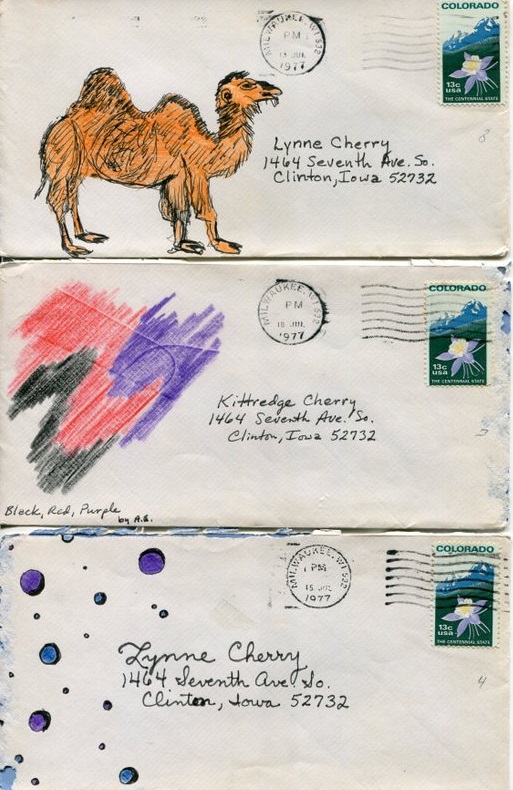
Many envelopes are influenced by the modern-art classes that Kitt and Audrey were taking together.
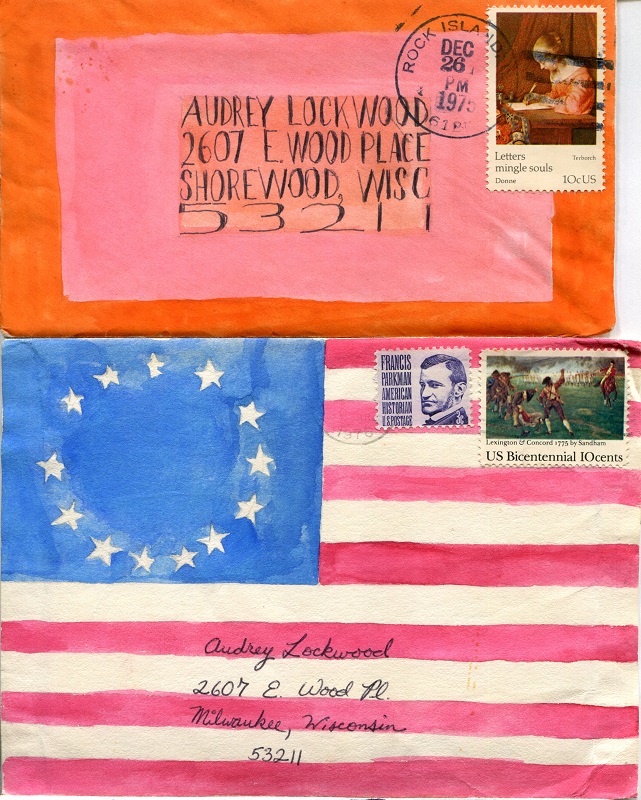
The orange envelope on top, postmarked Dec. 26, 1975, is probably the oldest envelope in this collection. The United States celebrated its Bicentennial in 1976, so the original 13-star Betsy Ross flag became an envelope design that year.
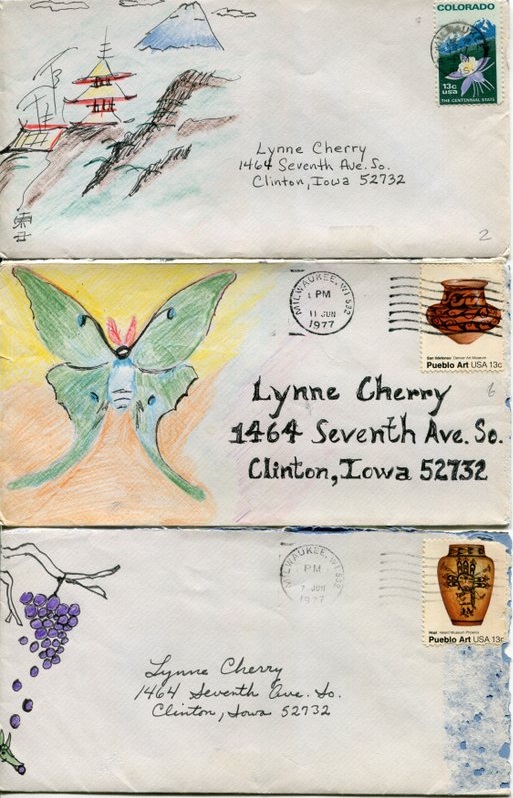
Their shared love for Asian culture is illustrated on the love-letter envelopes. Later Kitt and Audrey would live together in Tokyo, Japan.
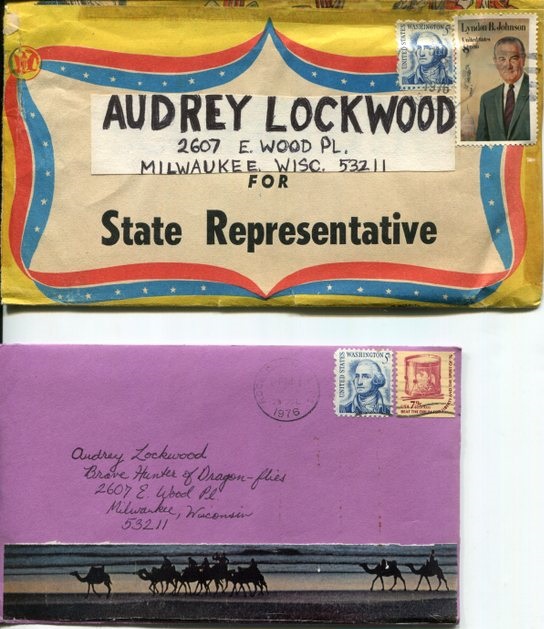
Kitt encouraged Audrey’s dreams of running for political office by designing an envelope to look like a campaign flier.
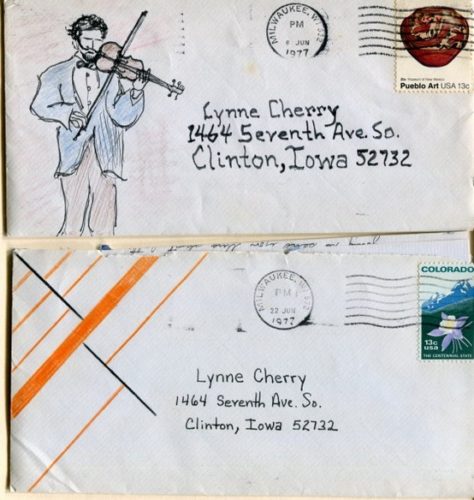
A violinist herself, Audrey drew a man playing a violin.
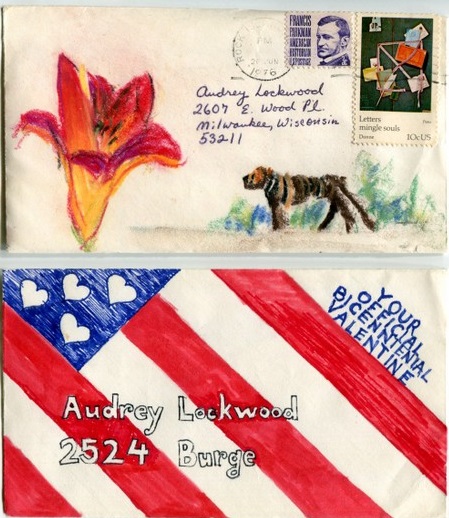
Unlike the other envelopes, the “official Bicentennial Valentine” on the bottom is addressed to Audrey’s dormitory room at the University of Iowa.
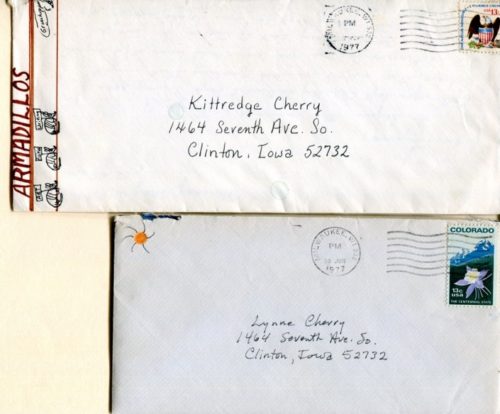
Armadillos march on the edge of the envelope with signs saying, “Art,” “Politics” and “Writing.”
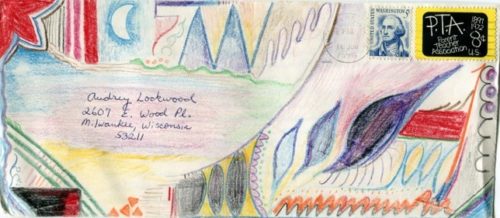
Modern artists inspired some envelopes. This one shows the influence of Wassily Kandinsky,
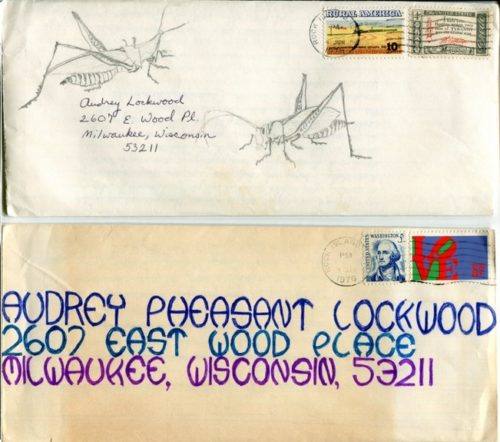
Grasshoppers and pheasants were part of Kitt and Audrey’s imaginative menagerie. Note the “Love” postage stamp designed by Robert Indiana.
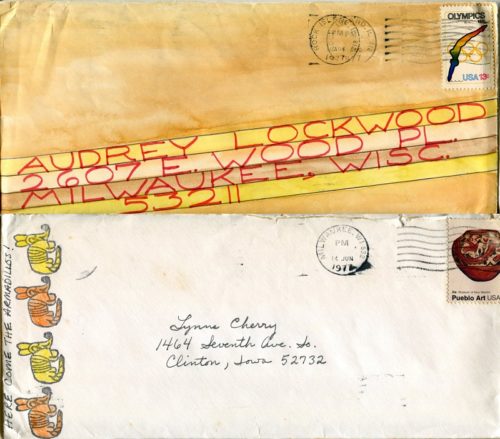
“Here come the armadillos!” Audrey had a rubber stamp based on her original drawing of an armadillo. Here she colored in the stamped images orange and yellow.
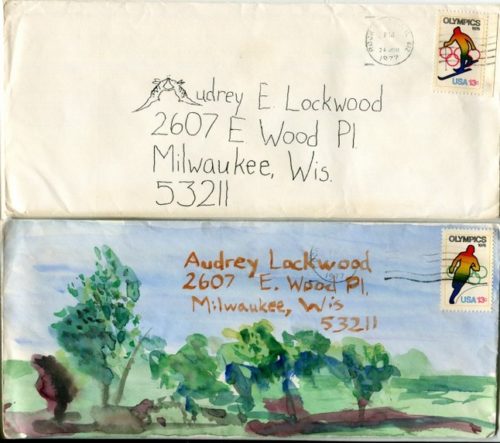
A pair of kissing armadillos form the “A” in Audrey. The landscape painting looks like it was inspired by the view of an arboretum near the Cherry family home. The postage stamps honor the 1976 Olympics.
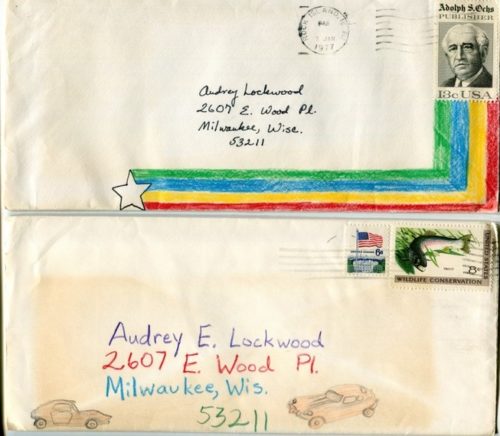
Kitt probably sketched eraser cars from her childhood collection of erasers made by Diener Industries.
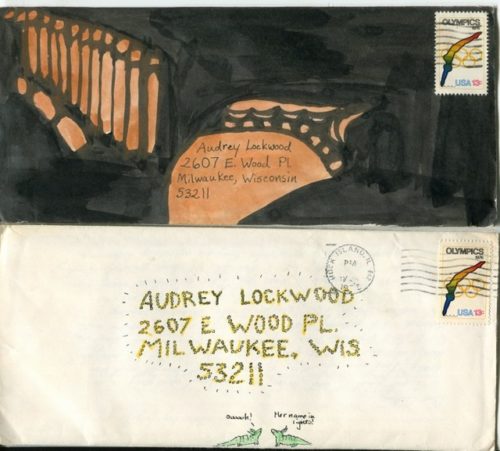
Armadillos admire “her name in lights.”
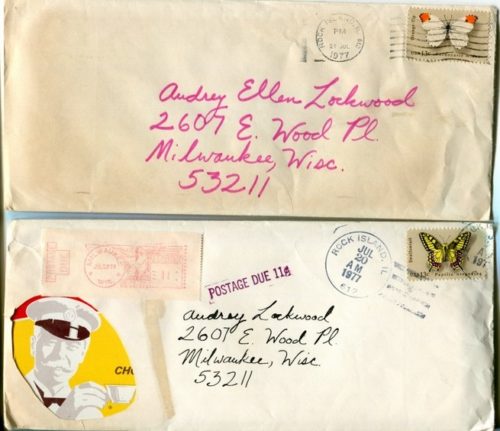
Kitt and Audrey loved drinking tea together from the first night they met. Even ordinary Lipton Tea seemed romantic, so Kitt cut their logo from a cardboard box of tea and made it into an inset for an envelope. The Post Office charged an extra 11 cents for the added weight. Butterfly stamps provided the finishing touch.
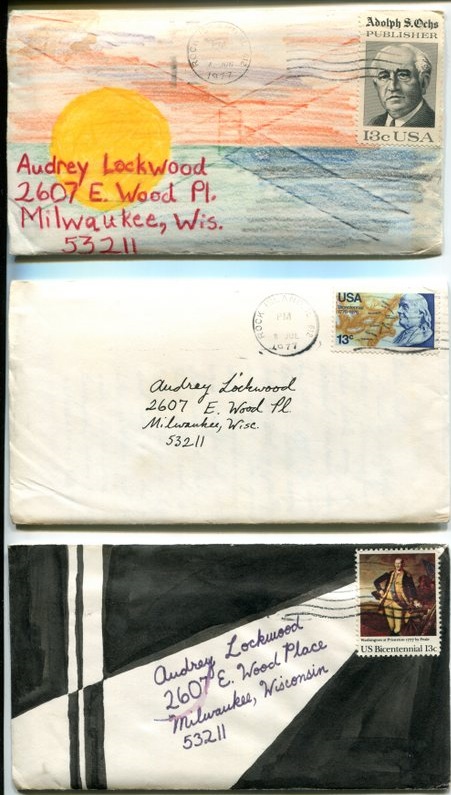
Kitt and Audrey used a wide variety of styles and media on their envelopes.
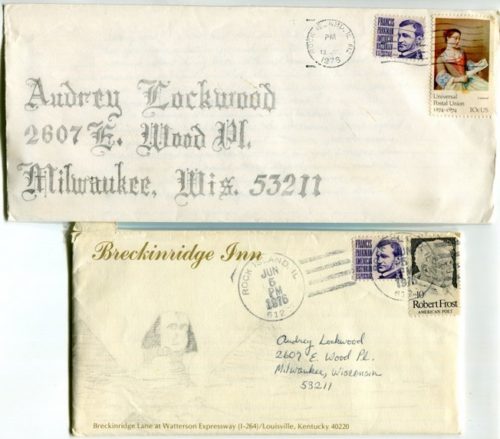
Kitt used pencil to draw Old-English calligraphy and the mysterious Sphinx.
Kitt often added small ink drawings of an armadillo interacting with a green ball on the backs of her envelopes. Here are a few highlights.
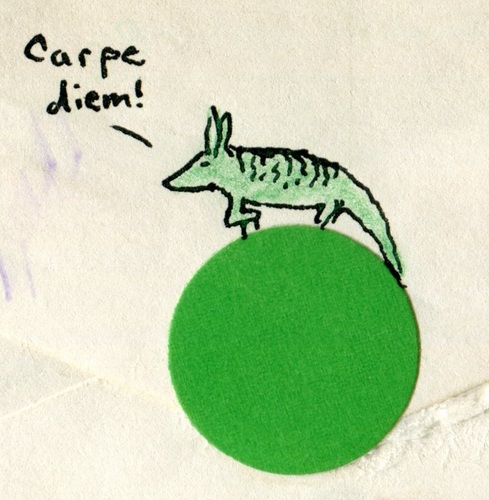
Armadillo says, “Carpe diem!” That’s Latin for “Seize the day!” Kitt learned the phrase from Audrey and her mother, Eileen Lockwood, who both loved Latin.
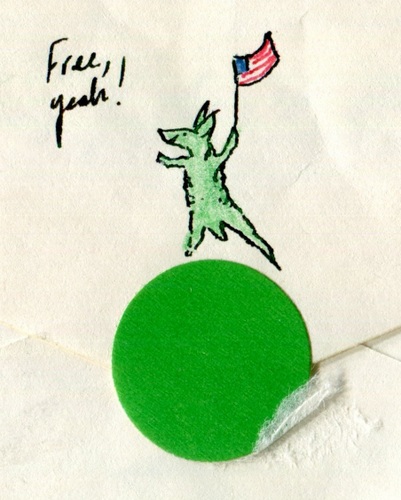
Armadillo dances and sings, “Free, yeah!” It comes from “Fill Your Heart” by David Bowie, a favorite song of Kitt and Audrey.
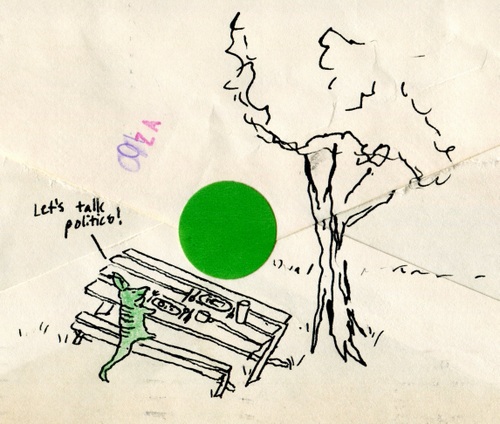
Armadillo sits at a picnic table with Green Ball and says, “Let’s talk politics!”
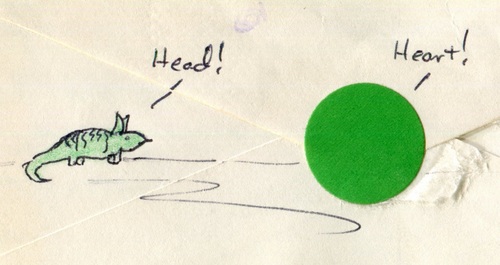
Armadillo says, “Head!” Green Ball says, “Heart!” This echoes discussions between intellectual Audrey and artistic Kitt.
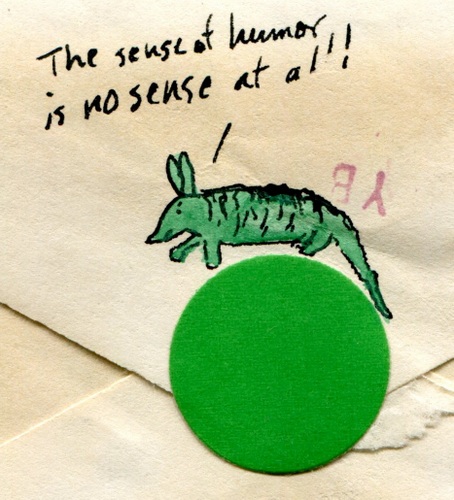
Armadillo says, “The sense of humor is no sense at all!” This was probably a direct quote from Audrey.
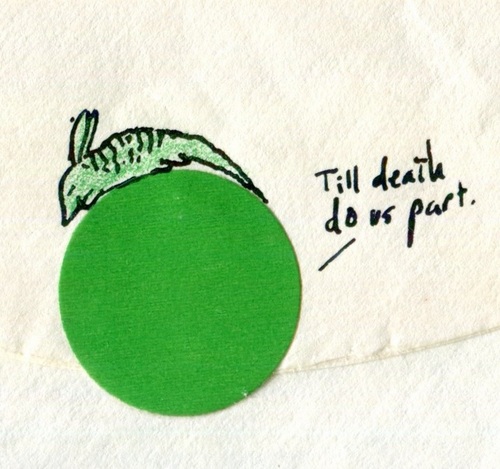
Green Ball says to Armadillo, “Til death do us part.” Looking back, Kitt is surprised that she put these words from the traditional wedding vow onto an envelope for public view in 1977, even in coded form.
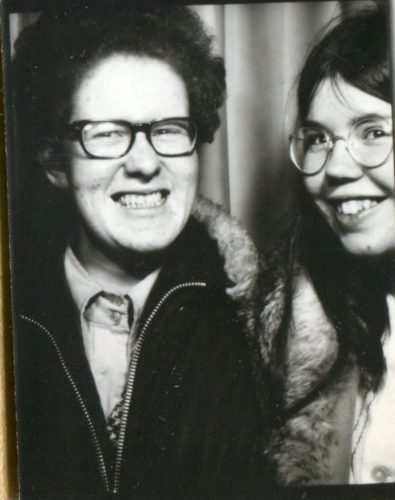
Kitt and Audrey posed together in a photo booth soon after they met in 1975.
___
This article was originally published on Q Spirit on May 4, 2022.
Copyright © Kittredge Cherry. All rights reserved.
Qspirit.net presents the Jesus in Love Blog on LGBTQ spirituality.

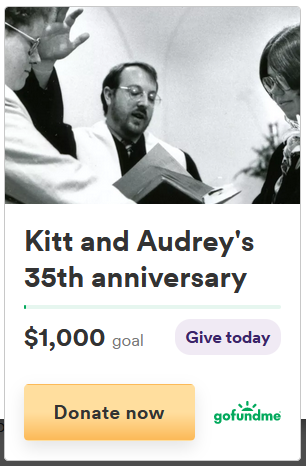






Your artistically embellished correspondence with Audrey is a treasure. Seems like a good subject for a romantic movie. Have you thought about bequeathing your letters to any queer archives? The ones that come to mind are the Lesbian Herstory Archives in NYC and the Sexual Minorities Archives in Holyoke, MA.
I have read both of those books! They were very eye opening! I am glad I could “I Spy” a criptic message you may have forgotten!
What a treat! I really enjoyed seeing all of these envelopes. I am curious about the first one…the scroll work has “sex” embedded in it but I can’t decipher the last two letterforms. That Audrey is a clever one!
Thanks for pointing out the word “sex” embedded in the decorative scrollwork on the first envelope. Believe it or not, Audrey and I didn’t notice that when we scanned the old envelopes, and we don’t remember it.
However around that time we were fascinated by the book “Subliminal Seduction” by Wilson Bryan Key. It revealed how words such as “sex” were embedded in advertisements to subconsciously seduce potential customers.
The reason I highlighted that envelope first was not so much because of the design, but because it is one of the only envelopes addressed to me as “Kittredge Cherry,” the name that I use now professionally, rather than as Lynne.
Another book that we read about sneaky advertising tactics was the classic “Hidden Persuaders” by Vance Packard. I believe that one was assigned reading in one of my journalism coursers.